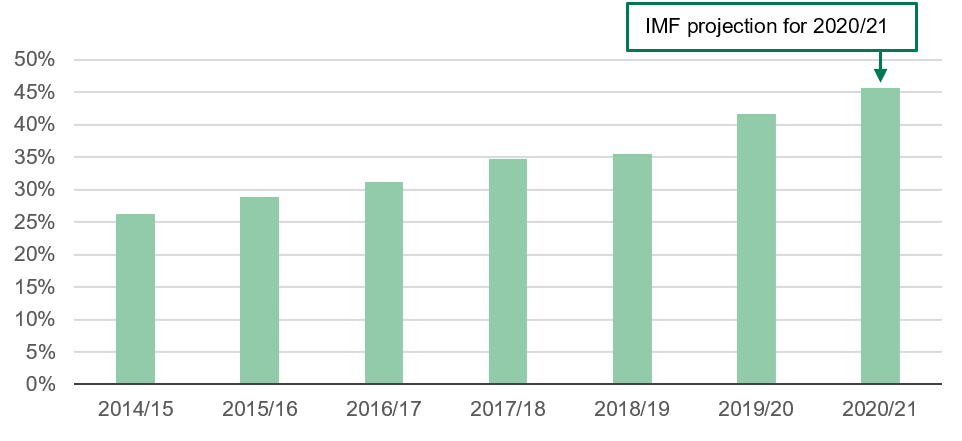Socioeconomic impact of Covid-19 in Uganda: How has the government allocated public expenditure for FY2020/21?
How will the Covid-19 pandemic affect people living in poverty in Uganda? This report looks at the Ugandan government's response measures in health, food, and water, sanitation and hygiene.
DownloadsExecutive summary
With just five Covid-19 related deaths reported so far, relatively lower numbers of confirmed cases and a high rate of recoveries, Uganda’s tightly-controlled response to the Covid-19 pandemic seems to have had a more positive outcome than its neighbours.
However, while the measures have succeeded in containing the outbreak so far, they have also caused significant damage to the economy. This is likely to impact most on the poorest and most vulnerable sections of society. As a result, the socioeconomic consequences of Covid-19 are likely to heavily outweigh the positive health impacts in Uganda.
Key findings and conclusions
A likely increase in poverty as the economy slows down: The economy is projected to have slowed down by nearly half for the financial year 2019–2020 (referred to throughout as FY2019/20), with further uncertainties for FY2020/21. This increases the likelihood of a rise in poverty during and after the Covid-19 pandemic. Many people face a reduction in their income due to job and livelihood losses, reduced flow of remittances, loss of market and demand for domestic products.
Growing public expenditures not linked to Covid-19: The budget expenditures for FY2020/21 have grown compared to that for FY2019/20. However, the increase does not seem to be driven by the anticipated cost of Covid-19 response measures in FY2020/21. The structure of the current budget remains largely similar to the previous financial year despite the overwhelming impact of the pandemic on Uganda’s economy and resource basket for FY2020/21. Works and transport remain the most funded sectors, and security, interest payments and education received increased investment. This reflects the same patterns as previous years, with these sectors as the top financed sectors of the economy.
Major shortfalls in domestic revenues: While total revenue is expected to grow, Uganda’s revenue collection will be affected by the pandemic. Major shortfalls have already been registered in FY2019/20. There are also projections for declines in FY2020/21 targets. These projections are based on a situation where the virus is quickly contained, but these shortfalls could significantly exceed projections if the current restrictive control measures continue.
Increasing public debt: Major shortfalls in revenue collection pushed the government into high levels of borrowing to cover its fiscal deficit for both FY2019/20 and FY2020/21. If this continues, it will contribute to a further increase in the total public debt, which has grown from 22.4% in 2010 to a projected 41% of GDP by the end of FY2019/20. As a result, Uganda’s debt servicing commitments will continue increasing, as rising external public loan financing requires high commitment fees, and non-concessional domestic borrowing attracts huge interests. Interest payments alone will take up 9 per cent of total resource envelop for financial year 2020/2021, thus more money is being allocated to interest payment and away from service delivery or development spending that could benefit people living in poverty.
Unequal targeting of Covid-19 response measures: Over 8 million Ugandans (19.7%) live below the national poverty line. However, the government’s Covid-19 relief programmes, like food and other relief aid, have been directed primarily at the 1.5 million people living in urban areas in the Kampala and Wakiso districts, rather than those in rural areas. Similarly, the government’s response measures are focused on the formal sector, meaning that they will not reach the poorest and most vulnerable citizens. These people tend to work in the informal sector and are unable to access government measures like loans and tax benefits. This is likely to cause further inequality between rural and urban populations, and exacerbate poverty and vulnerability.
Disruption of service delivery in health and other sectors: Due to Covid-19, Ugandans living in poverty who rely on the government’s free healthcare programmes have experienced a reduced access to primary healthcare. As a result, Uganda has registered an increase in number of preventable deaths during childbirth and in other health emergencies, and an increased occurrence of deaths due to preventable disease like malaria. Access to family planning and other healthcare programmes has also been compromised.
Recommendations
This paper therefore provides the following recommendations:
- Urban and formal sector learning measures need to be applied in a way that is clear and inclusive with a short-, medium- and long-term plan for mitigation, recovery and resilience building. This is the only way to ensure that the damaging impacts of the severe lockdown and other Covid-19 response measures on the economy, people’s livelihoods and welfare are properly documented and addressed equitably.
- A clear government response strategy is needed, to ensure adequate attention and protection for the poorest and most vulnerable sections of the population. This will protect against the negative impact of the pandemic on the health and livelihoods of the most vulnerable.
- The FY2020/21 funding allocation to pro-poor sectors, such as health and social protection, needs to be revised to reflect sector needs and accommodate additional constraints imposed by Covid-19. This will enable the government to, for example, fast-track the expansion of its social protection programmes and serve as a more direct, sustainable and inclusive mechanism for protecting people living in poverty.
- The drawbacks of the restrictive Covid-19 response measures should be documented across sectors and used as lessons for designing responses in future crises. This will prevent inadvertent loss of many lives from existing and manageable conditions due to poor responses to crises in future.
- The government needs to pay close attention its rising fiscal deficit and the increase in public debt towards unsustainable levels. The increase in loans to deal with the implications of the Covid-19 pandemic should be checked. This calls for clear mechanisms for good public debt management as well as the efficient use of available resources to avoid slipping deeper into debt stress.
Introduction
This paper looks at the socioeconomic impact of the Covid-19 pandemic in Uganda, and the impact on people living in poverty. It focuses on the government’s financial response and the likely effects on the health, food security/vulnerability, and water, sanitation and hygiene (WASH) sectors. These three areas have significant potential to support people living in poverty to mitigate the effects of the pandemic on their health and livelihoods.
Even before registering its first case, the government took proactive measures to prevent the spread of Coronavirus, which was already present in most of Uganda’s neighbouring countries. This involved implementing one of the strictest lockdowns in sub-Saharan Africa. Combined with Uganda’s high poverty rates and the challenges it faces with social sector service delivery, it is imperative to look at the impact of both the pandemic, and the government’s Covid-19 response measures on people living in poverty.
The government’s initial Covid-19 response measures included closing all educational institutions, banning public gathering and imposing travel restrictions to and from affected countries. With several additional measures implemented, Uganda managed to keep the number of registered positive cases of Covid-19 below 150 until 20 May. However, following the relaxation of lockdown measures on 21 May, the number of infections started to rise quickly. At least five Covid-19 related deaths have so far been reported, while 1,102 recoveries have been reported out of the total 1,223 [1] positive cases from the 210,997 samples tested as of 5 August. [2]
Despite Uganda’s relatively low numbers of infection, some of the response measures, like the lockdown, night curfew and closed borders, have significantly disrupted economic activity. While many restrictions have now been partially lifted, the rapid rise in number of new infections has forced the government to maintain some districts under lockdown, with another nationwide total lockdown likely. [3]
With some lockdown measures still in place, the socioeconomic impacts of Covid-19 are disproportionately affecting the poorest sections of society. In Uganda, the informal sector is comprised largely of micro and small enterprises (MSEs). It makes up 50% of the economy and employs 98% of the working age labour force. [4] This sector has been one of the hardest hit, with people engaged in trading, services and hospitality most affected by Covid-19 restrictions. The direct impact of Covid-19 has caused the loss of jobs and incomes, with worst cases of MSE owners experiencing incomes falling below zero, resulting in the discontinuation of their business activities. [5] It is estimated that about 23% of the urban poor could have lost 100% of their daily income during and after the lockdown. [6] The MSEs that remain afloat are facing worse credit and liquidity constraints than they did prior to the pandemic. [7] As a result, the socioeconomic consequences of Covid-19 currently outweigh the positive health impact of limiting its spread.
While fiscal policy plays an important role in mitigating the pandemic’s impact and promoting quick recovery, [8] the impact of Covid-19 on Uganda’s economic output, domestic revenue mobilisation and public financing in 2020 and beyond is projected to be huge. [9] Shortfalls in revenue collection could significantly exceed projections if the spread of Covid-19 necessitates prolonged implementation of restrictive control measures.
Uganda is a poor country with a GDP per capita of US$776.7 (UGX2.86 million, converted on 7 August 2020), [10] yet it spends a significant chunk of its budget on debt servicing, with 9% and 2.7% of the FY2020/21 budget allocated to interest payments and external debt repayments, respectively. Despite having a substantial fiscal deficit, Uganda already applied several financial instruments in the FY2019/20 and put in place other measures in the FY2020/21 budget to deal with the impact of Covid-19. Funding for these instruments has mostly come from loans sourced from private domestic and crossborder public bilateral and multilateral sources. However, the rising expenditure on debt servicing is of little benefit to poor Ugandans when more money is spent on debt than on delivery of services that directly benefit them.
Uganda’s Covid-19 response measures have already strained the implementation of the FY2019/20 budget. They added costs on several activities that were not foreseen or planned for, and forced the government to resort to supplementary budgets to cover the gaps. The pandemic has also affected the FY2020/21 budget and caused pressure on already limited resources, as the government allocates funds to various Covid-19 response activities and revises downwards revenue collection targets for the current and next financial year.
A key challenge for Uganda’s response to Covid-19 is how to balance response measures with the need for continued implementation of service delivery and development programmes in line with the country’s medium- and long-term development targets. Allocation of budget resources for Covid-19 response shows low government expenditure in some sectors and poor targeting. Covid-19 relief and humanitarian assistance has been largely focused on urban areas and formal sectors. This neglects the rural areas where the vast majority of poor people live and the informal sectors where they make a living.
The state of the Covid-19 pandemic
With over 210,997 people so far tested for Covid-19, Uganda’s test rate stands at approximately 4,900 per million. [11] As of 5 August 2020, the number of confirmed cases stood at 1,223, with 1,102 (90%) recoveries and five deaths out of total number tested. [12] While the cumulative number of confirmed cases continues to rise, the number of recoveries is also rising fast. As a result, the number of active cases remains small (Figure 1).
While Uganda continues to register new cases of Covid-19, the Ministry of Health suggests that most (57%) of all Uganda’s infections have been imported into the country by cross-border truck drivers and other people crossing into the country. [13]
Being a landlocked country and a gateway to other landlocked neighbours, Uganda has limited options in banning truck drivers from neighbouring countries. It also cannot completely shut down its borders. All cargo shipments of essential goods to Uganda and other landlocked countries, like South Sudan, Rwanda, Burundi and eastern Democratic Republic of the Congo (DRC), pass through Uganda.
To deal with this, it became compulsory from the 16 May for all foreign truck drivers to be tested for Covid-19, and only those with negative results are allowed to enter the country. [14] Overall, it is widely believed that Uganda’s achievement in fighting Covid-19 to date is largely attributed to the strict response measures taken by the government. [15]
Figure 1: Covid-19 cases in Uganda, 5 August 2020
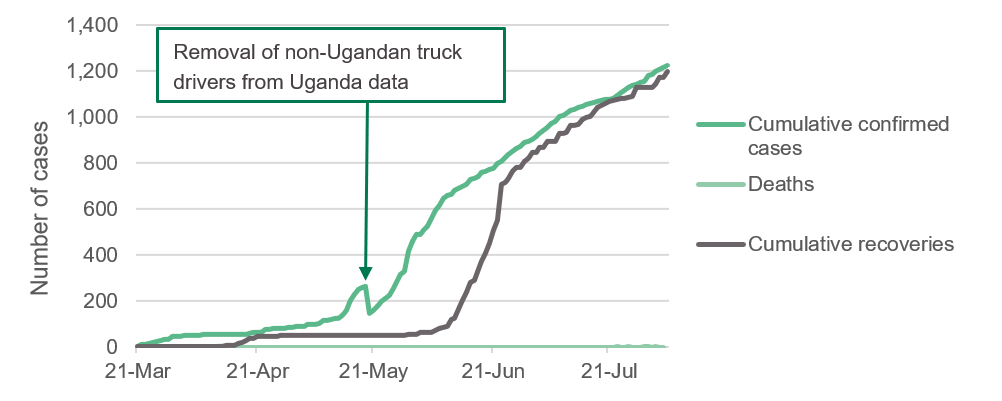
Figure 1: Covid-19 cases in Uganda, 5 August 2020
Source: Development Initiatives based on data from the government of Uganda. [16]
Government response to the Covid-19 pandemic
Knowledge of the devastating impact of Covid-19 and its relatively quick mode of transmission within the population prompted the government to take serious mitigation measures, even before registering a single case in the country. These initial measures were announced on the 18 March 2020, and included closure of all primary and secondary schools, universities and other institutions of learning, suspension of religious gatherings across the country, and the banning of public rallies and cultural meetings. They also included a travel ban for Ugandans to high-risk countries and strict quarantine measures for all returning Ugandans at their personal cost. [17]
These measures were followed by a total nationwide lockdown and curfew, and a series of standard operating procedures (SOPs) to guide the operation of institutions that were deemed essential, such as banks, funeral homes, garbage collection companies, water and electricity distributors, the roads maintenance agency and the tax collection authority. However, even these were directed to encamp their essential staff or obtain special exemption from the government to enable them to continue operating during the lockdown. Uganda’s lockdown is generally considered one of the most severe in subSaharan Africa.
As a result, all non-essential services and activities remained closed from 31 March until the partial lifting of the lockdown on 26 May. This resulted in a major disruption of economic activity, as people had little to no freedom of movement to go and buy essential commodities. [18] As a result, the economy suffered, and continues to suffer, as activities in manufacturing and industry, services and informal sector have been either reduced or halted.
Despite the government’s ability to initially slow the course of the Covid-19 pandemic in Uganda, the severity of the response measures enforced has negatively impacted on the economy with far-reaching effects on all sectors projected for the medium to long term. The country continues to face high poverty rates, and an economy largely composed of the informal sector. The pandemic has also brought to the forefront Uganda’s challenges in dealing with poverty and vulnerability.
In the following sections, we review the government’s Covid-19 response measures in areas that directly address health and livelihoods, and that are deemed to have a disproportionate impact on people living in poverty. These include water, sanitation and hygiene (WASH), social protection, food security and health. This is followed by an analysis of possible effects that these measures are having on the economy, poverty and vulnerability. The last section presents conclusions and recommendations.
Financial measures
The government has relied heavily on fiscal policy to respond to Covid-19, mitigate its impact on the economy and promote quick recovery. On 11 June, the minister of finance read the UGX 45.5 trillion national budget for FY2020/2021, [19] dubbed the ‘Covid-19 budget’. While this budget is UGX 6 trillion or 12.36% higher than the approved budget for FY2019/20, much of this increase does not seem to be driven by the anticipated cost of responding to the impact of the Covid-19 pandemic in FY2020/21. In fact, the structure of the budget has remained largely similar to that approved for FY2019/20.
Infrastructure development remains Uganda’s most funded activity, while the key drivers of the budget increase are the increased allocations to security, interest payments and education. These are also among the usual top four financed sectors of the economy. Domestic and external debt servicing also continues to take the largest share of resources from Uganda’s budget (Figure 2). The budget allocation to the Ministry of Health (leading the Covid-19 response) was only marginally increased, despite the additional demand that the Covid-19 pandemic has added to the sector.
Figure 2: Same budget structure for FY2020/21 and FY2019/20 despite the Covid-19 pandemic and increased fiscal basket for FY2020/21
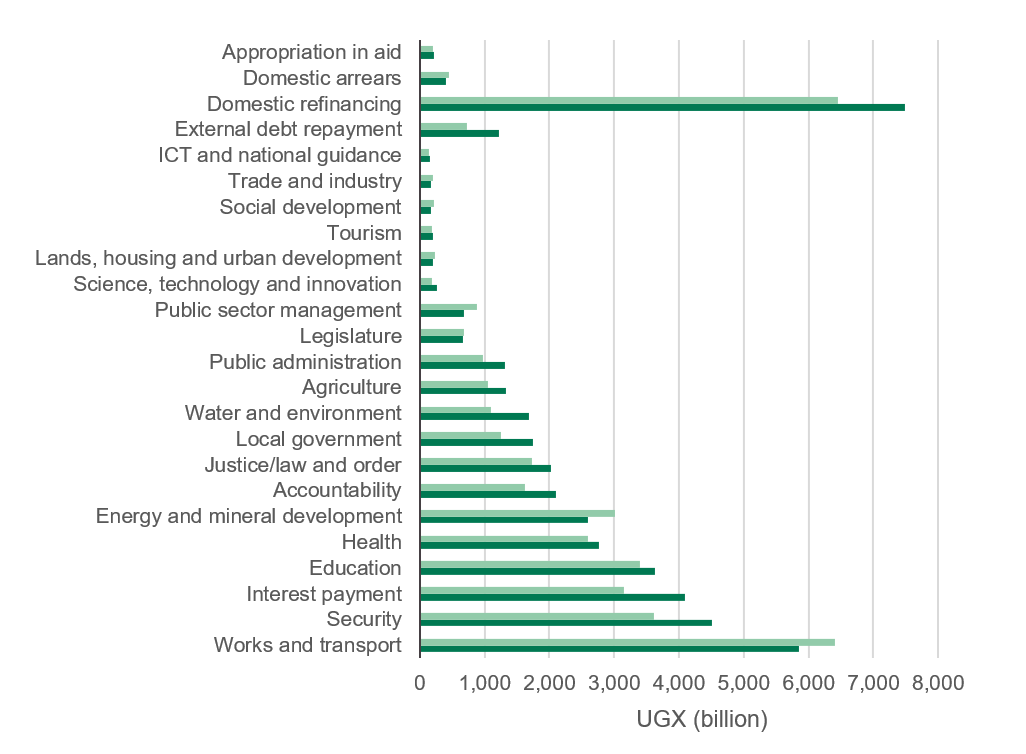
Figure 2: Same budget structure for FY2020/21 and FY2019/20 despite the Covid-19 pandemic and increased fiscal basket for FY2020/21
Source: Development Initiatives based on data from Ministry of Finance. [20]
Out of the total resource envelope of UGX 45.5 trillion for FY2020/21, UGX 37.8 trillion (or 83%) will be available for expenditure on the various sectors of the economy. The balance goes to domestic refinancing (UGX 7,486.1 billion) and appropriation in aid (UGX 215.6 billion). [21]
Uganda’s primary response to the pandemic was implemented through three key measures. Firstly, a UGX 304 billion supplementary budget was approved by parliament on 7 April to facilitate an immediate response to Covid-19. This appropriation was notably small in comparison to the overall FY2019/20 budget and only represented 12% of the health sector budget for FY2019/20. The budget was then distributed across multiple sectors, including health (UGX 82.6 billion), security (UGX 81.5 billion), Office of the Prime Minister’s disaster management (UGX 59.4 billion), local governments (UGX 36.1 billion), Kampala City Council Authority (UGX 30 billion) and the Information Communication Technology (ICT) ministry (UGX 14 billion). UGX 10 billion was allocated to members of parliament. [22]
Secondly, the government launched the National Response Fund to Covid-19 [23] to raise additional funds for Covid-19 response. The government target is to raise over UGX 170 billion from the public through this fund to support efforts to curb the spread of Covid-19. [24] A total of UGX 50 billion (or 30%) has so far been collected, with UGX 17 billion in cash and UGX 33 billion in-kind (including vehicles, food and medical equipment). [25] According to the government, most of these funds will go towards the purchase of additional personal protection equipment (PPE), testing kits and support materials for medical teams on the front line.
Thirdly the Bank of Uganda lowered its lending rate from 9% to 8% in April 2020, in a bid to ensure adequate access to credit and promote the normal functioning of financial markets. It is hoped that this will lessen the impact of the Covid-19 pandemic on the Ugandan economy. [26] However, formal credit and lending is largely dominated by commercial banks whose services do not reach people living in poverty. Poor or vulnerable people are often unable to meet the banks’ stringent lending requirements, including high minimum balances for opening an account, difficult collateral requirements for loans, and costly bureaucratic processes. [27] In Uganda only 4% of Ugandan adults use formal lenders to access credit, while 1% use both informal and informal sources. The remainder of people who borrow money use other sources to access credit, including family and friends. [28]
As the government’s measures appear to be focused primarily on alleviating pressures on the formal sector, their ability to directly benefit people living in poverty who are mainly engaged in the informal sector is not clear. Commercial bank’s lending rates have remained high at an average of 21% since the early 1990s, despite previous policies aimed at lowering the rates. [29] Even then, the government continues to rely on the same banks to reach people living in poverty, yet the banks seldom apply the reduced rates from the Central Bank to small and medium scale enterprises (SMEs) and poor farmers that they deem to be high-risk borrowers.
Just a few days before the end of FY2019/20, the Ugandan parliament passed an additional UGX 1.08 trillion in supplementary funding to the government. While the additional funding was requested to enable government to cater for the mitigation of the negative social and economic impact of Covid-19, the allocation of the funds does not appear to have been used to support those people living in poverty who are being worse affected.
The top beneficiaries of the supplementary budget were the Ministry of Finance, who allocated UGX 455 billion to finance the Uganda Development Bank (UDB). Another UGX 223 billion was earmarked for clearance of domestic arrears. UGX 105 billion was allocated to social protection. This allocation is spread out as follows:
- UGX 10 billion to agriculture to enhance households’ capacity for food security
- UGX 45 billion to support social services infrastructure such as schools, health units and water points that serve communities that have been worst hit by natural disasters
- UGX 50 billion for transfer to the microfinance support centre to support micro and small-scale enterprises.
The Ministry of Health was allocated UGX 89 billion to deal with the Covid-19 pandemic, with specific allocation for medical personal protective equipment (PPE), distribution of Covid-19 test kits and laboratory equipment (Figure 3).
Figure 3: Allocation of the UGX 1.09 trillion June supplementary for budget FY2019/20
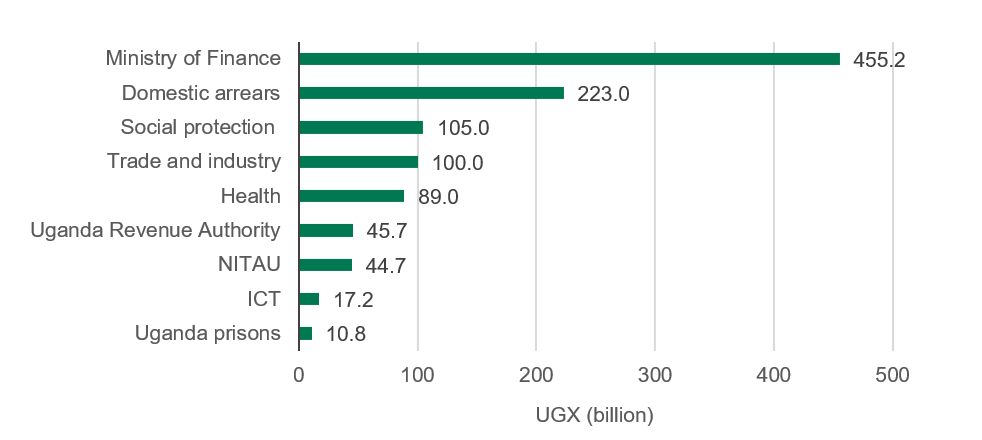
Figure 3: Allocation of the UGX 1.09 trillion June supplementary for budget FY2019/20
Source: Development Initiatives based on data from the Parliament of Uganda. [30]
Note: NITAU = National Information Technology Authority Uganda; ICT = Information and Communication Technology
Besides the measures that were already in place for FY2019/21, in his FY2020/21 budget speech, the minister of finance [31] identified a series of financial measures aimed at mitigating its impact on various sectors of the economy. The financial measures include economic stimulus packages for SMEs, tax relief and investment in the national Youth Livelihood Fund (YLF) and National Agricultural Advisory Services (NAADS) in order to create more jobs and keep young people in employment.
The government’s priority areas for Covid-19 impact mitigation, therefore, include employment, which has been allocated UGX 430 billion, social welfare, which has been allocated UGX 152 billion, and business, which has had UGX 2,136 billion allocated. Details of these are presented in Table 1.
However, the ability of many of the Covid-19 impact mitigation measures to have a positive impact on people living in poverty and other vulnerable groups is unclear, as many of these measures do not directly target them. For example, the most funded measure – the ‘recapitalisation of the Ugandan Development Bank’ – was allocated UGX 1,045 billion to extend liquidity to the private sector in the form of low interest loans. This is unlikely to reach people living in poverty due to physical, socioeconomic and other barriers, and the fact that the majority are employed in the informal sector with no access to formal credit.
Table 1: Key financial measure for Covid-19 impact mitigation in FY2020/21 budget
| Sector | Activity | Allocation (UGX billion) |
|---|---|---|
| Employment | To NAADS for enhancing agriculture sector activities through increased supply of agricultural inputs to famers and upscaling agricultural extension services | 300 |
| Job creation for vulnerable able-bodied persons affected by Covid-19 though expanding labour intensive public works in urban and peri-urban areas | 130 | |
| Social welfare | Provision of government relief aid in response to Covid-19 and other disasters | 45 |
| Allocation to Social Assistance Grant for the Elderly (SAGE) nationwide roll-out to persons aged 80 years and above | 107 | |
| Business | Credit facility to small and medium enterprises (SMEs) | 94 |
| Allocation to Uganda development corporation in support of Uganda's import substitution and export promotion strategy | 138 | |
| Corporate income tax payment deferral | 13.88 | |
| Pay as you earn (PAYE) tax payment deferral for businesses facing hardships | 65.6 | |
| Expedite payment of arrears owed by the government to private sector | 673 | |
| Waiver of interest on tax arrears | 50 | |
| Provision of tax deduction on donations to Covid-19 response | N/A | |
| Expedite payment of outstanding value added tax (VAT) refunds | 120.53 | |
| Recapitalisation of Uganda Development Bank (UDB), to provide low interest financing to manufacturing, agribusiness and other private sector firms | 1,045 | |
| Total | 2,611.48 |
Source: The Government of Uganda National budget speech FY2020/21. [32]
Health measures
Total nominal allocation to the health sector for FY2020/21 increased to UGX 2.7 trillion from UGX 2.5 trillion in FY2019/20. This reflects an increase of over UGX 200 billion (4%) from the previous financial year’s allocation. Allocations to the health sector, however, accounted for a decreasing share of the national budget from FY2018/19 to FY2020/21. The Covid-19 crisis has not affected the trend of the last two years, which has seen proportions of budget allocated to health fall, now reaching the lowest proportion since 2015.
This reality is far detached from the expectation of increased health sector financing. In fact, projected funding requirements for the health sector show that the sector has been consistently underfunded throughout the second National Development Plan (NDP II) period. In the FY2019/20, the sector experienced a funding gap, with approximately UGX 14,000 billion in additional funding needed to meet its development targets for the financial year under the health sector development plan FY2015/16 to FY2019/20 – five times the value of what was allocated (Figure 4).
Figure 4: Health sector allocations, FY2015/16 to FY2019/20 (nominal)
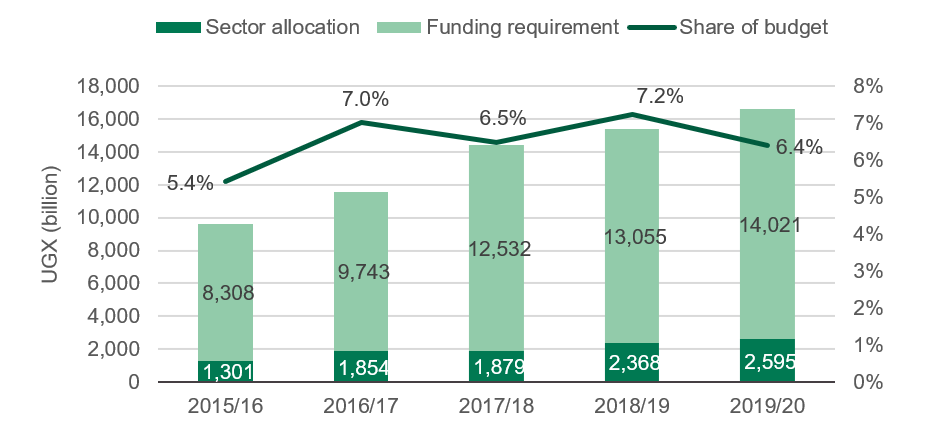
Figure 4: Health sector allocations, FY2015/16 to FY2019/20 (nominal)
Source: Development Initiatives based on data from the Uganda Ministry of Finance. [33]
The government has earmarked UGX 183 billion out of the total sector budget increase for FY2020/21 to recruit additional health workers and provide for their welfare. However, the health sector funding in relation to need remains low. Additional funding to the health sector during the Covid-19 pandemic would enable the government to continue implementing key health sector programmes, without compromising its Covid-19 response.
Instead, low funding to the sector has required the government to source vehicles and personnel from other government sectors to support the health sector in the face of the Covid-19 pandemic. Even then, the sector still has difficulty providing services required by people in communities who are located far from health centres.
More funding to the health sector would permit the government to address its health sector challenges and implement the key World Health Organisation (WHO) recommendations such as expansion, training, and deployment of healthcare and public health workers to effectively isolate, test, treat and trace cases of Covid-19.
Even when faced with these challenges, Uganda has so far largely managed to contain the spread of Covid-19 in the community. Most cases that have been reported are said to be mild and did not require intensive care. However, the potential for community transmission with severe cases remains high, as the government struggles to contain new infections from cargo truck drivers entering Uganda from neighbouring countries like Tanzania and South Sudan. With a total of just 200 intensive care unit (ICU) beds, approximately 421 ambulances [34] each serving approximately 100,000 people and 77 of Uganda’s 134 districts lacking ambulances, Uganda’s weak healthcare system may not manage to handle a widespread escalation of Covid-19 infections.
In addition, with much attention shifted to containing and managing the spread of Covid-19, the health sector risks losing focus on the essential provision of primary healthcare and other basic health services. The Covid-19 pandemic has also amplified existing health sector challenges, like the low number of hospital beds (0.5 per 1,000 people [35] ), inadequate human resources (at about 2 doctors per 10,000 people [36] ), low government funding, inadequate and poorly maintained medical equipment, health personnel absenteeism and a low coverage of healthcare services. [37]
Healthcare spending in Uganda remains low. For most regions in Uganda, it falls below UGX 10,000 per capita, with some areas like Kampala spending less than UGX 5,000 per person in the FY2016/17 (Figure 5).
Figure 5: Low per capita primary healthcare spending, FY2015/16 to FY2017/18
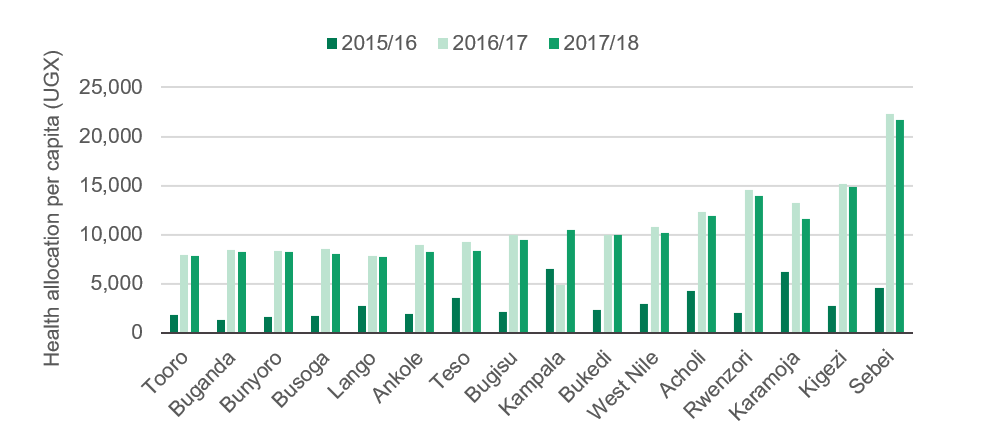
Figure 5: Low per capita primary healthcare spending, FY2015/16 to FY2017/18
Source: Development Initiatives based on data from the government of Uganda. [38]
With much of the health sector’s focus now shifted to addressing Covid-19, the implementation of Uganda’s free universal healthcare programmes at government health facilities has been affected. People living in poverty who mostly rely on free healthcare programs now have wait longer to access the services or give them up altogether due to travel and other restrictions that make it more difficult for them to access the health facilities. Other impacts of Covid-19 on the health sector are manifesting in the form of reduced attendance to their places of employment by healthcare professionals at a time when many districts have between 30–50% of their approved healthcare staff posts vacant, lack of stock of essential medicines in health centres and the increased incidence of preventable deaths.
Malaria, waterborne diseases and other noncommunicable diseases that are endemic in Uganda are likely to kill more Ugandans than Covid-19 during the pandemic. With an average of 16 malaria deaths per day since the beginning of the pandemic in the country, many Ugandans have lost their lives due to a preventable disease augmented by some of the restrictive Covid-19 response measures. Reported cases and deaths have already surpassed the average for a similar period in the previous years. [39]
Overall, a prolonged period of the total lockdown, followed by strict measures in partial lockdown, is likely to continue compromising access to healthcare for most people living in poverty in Uganda. People living in remote areas with limited access to health centres will be the most affected, as calls for social distancing and caution against overcrowding prevent people seeking medical help. Many health centres are also seeing problems with staff not attending their roles, due to the lack of safety equipment. Health facilities are also perceived by the public as hotspots for Covid-19 spread. [40]
Social protection and food security
The government aims to address the needs of vulnerable Ugandans through the implementation of social protection programmes in line with Sustainable Development Goal 1 (SDG1). Overall coverage of social security in the country stands at about 2%. [41] By 2017, the government had been able to reach about 148,286 youth through the Youths Livelihood Programme (YLP), and about 85,336 women through the Uganda Women Empowerment Programme (UWEP). [42] The government has prioritised expansion of existing social protection programmes under the social development sector to cover more beneficiaries within the existing age cohorts or to include new age cohorts for the period between 2020/21 and 2024/25. [43]
Some of the existing formal social care and support services in Uganda include the resettlement of abandoned children and street children, the care and protection of children in conflict with the law, and the provision of support to vulnerable children, persons with disabilities (PWDs) and older person. This has been possible through the implementation of social protection programmes funded by donors. [44]
Uganda’s financing of social protection remains extremely low with a high dependence on donor funding. The budget allocation to social protection for FY2020/21 is just 0.4% of the overall government budget. The coverage of the two main direct cash transfer programmes – the Senior Citizens Grant and Northern Uganda Social Action Fund 3 – is only 3%. This leaves the majority of the population uncovered. At a 0.14% share of gross domestic product (GDP) in FY2017/18, the financing of Uganda’s social protection is lower than neighbouring countries like Kenya and Rwanda who spend 0.4% and 0.3% of GDP respectively on direct income support. [45]
The World Bank warns that without significant investments in people, additional stress and emergencies, like epidemics and natural disasters, similar to the ongoing pandemic, are likely to increase the level of vulnerability for the 8 million Ugandans living in poverty, as well as the 5 million who got out of poverty in the past 10 years.
“Two out of three people who get out of poverty fall back in – that is about 1.4 people in the last household survey conducted in 2016. We need to consider the importance of investing in people, building their human capital, and providing them with the tools and assets to manage shocks and reduce their vulnerability.”
Tony Thompson, Uganda Country Manager, World Bank
While the government has stepped up efforts to pay all outstanding arrears during the Covid-19 pandemic, the UGX 25,000 (approximately US$7) monthly pay-out to people aged 80 or over under the Senior Citizen Grant programme may not cater for increased need during the Covid-19 pandemic. Efforts to increase the coverage of Social Assistance Grant for the Elderly (SAGE) programmes in the current FY2020/21 is a positive step towards inclusion. However, this will require creating special programmes for all vulnerable groups like persons with disabilities, and vulnerable children in order to improve both reach and targeting. This will also enable the government to deliver additional safety nets to poor and vulnerable people at a time of increased vulnerability and need. Current social protection programmes have very limited coverage and are not well targeted as several vulnerable groups are grouped together. When compared to need, the few programmes in place have left out significant numbers of vulnerable people. [46]
The social development sector budget for FY2020/21 is UGX 172.2 billion, down from UGX 219.2 billion in FY2019/20. A total of UGX 107 billion or 62% of the social sector budget has been allocated for nationwide roll-out of the Social Assistance Grant for the Elderly (SAGE) programme.
Allocation to social development as a share of national budget has also declined consecutively in the past three financial years (Figure 6). This decline has happened against a backdrop of consistent sector underfunding against need and an increased need for resources to finance the national roll-out of key social protection programmes.
Figure 6: Declining share of social development sector budget allocation, FY2015/16 to FY2020/21
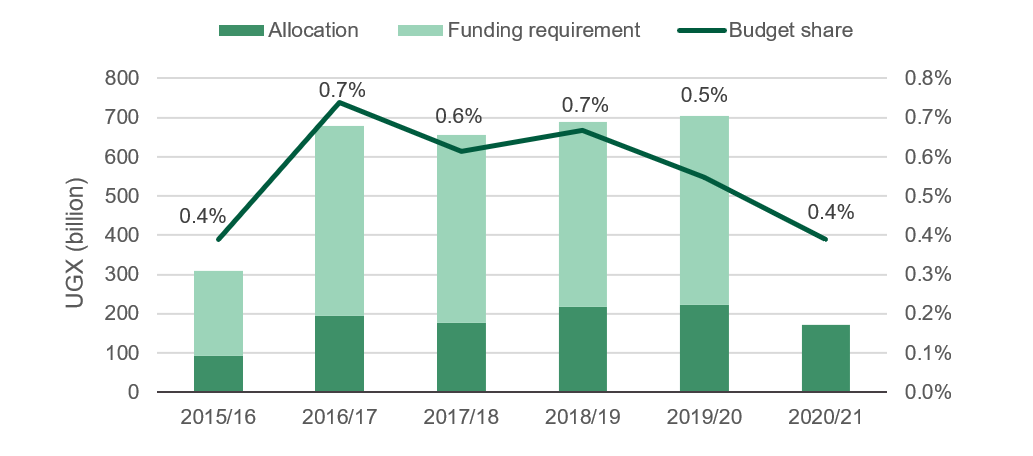
Figure 6: Declining share of social development sector budget allocation, FY2015/16 to FY2020/21
Source: Development Initiatives using data from the Uganda Ministry of Finance. [47]
On another front, the government commenced food relief distribution on 4 April 2020, targeting the vulnerable urban poor in Kampala and Wakiso districts. It was expected that relief food would be distributed to the over 1.4 million people in urban areas who cannot afford to feed themselves during the lockdown. [48] The budget for feeding the urban poor comes from the UGX 59.4 billion disbursed to the ministry office of the prime minister’s department for disaster preparedness and refugees from the Covid-19 supplementary budget.
However, the implementation of the government’s Covid-19 food relief programme has not gone as planned. Less than half of the people targeted in Kampala were reached by the end of the first 14-day period of the total lockdown. There were also irregularities in the selection of beneficiaries, and discrepancies in the quantity and quality of items distributed to households. [49]
The focus on urban areas in the Kampala and Wakiso districts also reveals a deeper problem. In a recent survey, the Ugandan Bureau of Statistics (UBOS) shows that the regions with the highest poverty rates are the Karamoja (61%), Bukedi (48%) and Busoga (42%) sub-regions. In contrast, Kampala and Wakiso have the lowest poverty rates of about 3%. [50] [51] This indicates that food relief distribution is not being targeted where the need is greatest.
Data and evidence on poverty distribution should ideally provide strategic guidance for the government in designing and improving the targeting of social welfare policies. It should also help prioritise an equal distribution of resources to reduce poverty and enhance household resilience, especially among vulnerable groups. [52] Unfortunately, this does not seem to have been followed in the implementation of some of the Covid-19 relief programmes.
In Uganda, the attributes often associated with poverty and vulnerability are: old age, disability, being part of a large family, belonging to an ethnic minority, living with HIV/AIDS, reliance on subsistence agriculture and working in the informal sector. [53] [54]
The government’s social protection programmes, like the Senior Citizens grant have provided valuable support to the section of the elderly population who access the grant. [55] They have also supported other vulnerable groups, like orphans and grandchildren who rely on their elderly grandparents for their livelihoods. [56] However, the limited coverage of these programmes means that many vulnerable people could face precarious conditions in the event of widespread Covid-19 infections. This is largely due to being unable to afford enough food to meet minimum energy requirements (caloric intake). Health experts warn that people have a better chance of surviving Covid-19 infection if they are adequately nourished and in good health condition. [57]
WASH sector measures
The water, sanitation and hygiene (WASH) sector budget for the FY2020/21 was boosted by an additional UGX 589 billion to be UGX 1.681 trillion for FY2020/21. This is up from UGX 1.092 trillion for the FY2019/20 (Figure 7).
Figure 7: Big gaps in WASH sector funding, FY2015/16 to FY2010/21
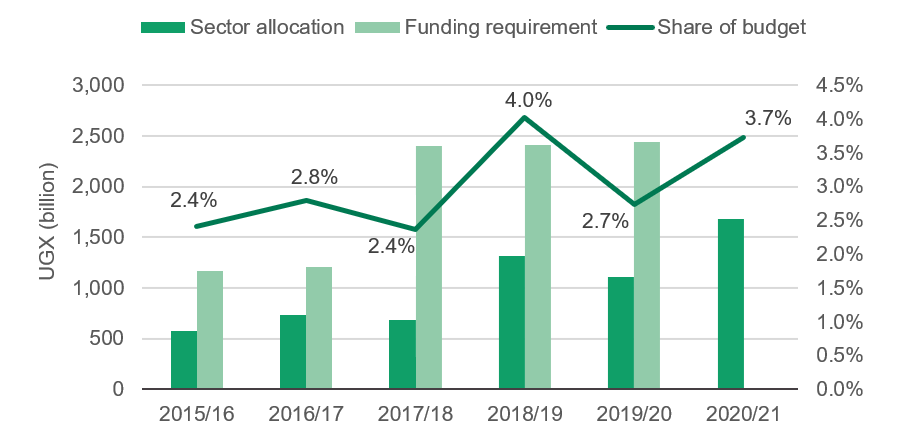
Figure 7: Big gaps in WASH sector funding, FY2015/16 to FY2010/21
Source: Development Initiatives based on data from Uganda Ministry of Finance. [58]
The 52% increase in WASH sector budget allocation for FY2020/21 is a positive step, but the sector has consistently been underfunded. The revised sector plan reveals that the WASH sector requires close to 10 times its current funding annually for the next 12 years to meet national development targets. [59]
It’s also worth noting that unlike the health, security, ICT and public services sectors that were awarded a supplementary budget for the Covid-19 response, the WASH sector did not get a share in the supplementary funding for the Covid-19 response in the current financial year. This seems to diminish the reality that most people targeted by Covid-19 relief food distribution reside in slums that have unplanned and crowded houses and no access to proper sanitation or clean water. As such, food may not be the only urgent need that the very poor and vulnerable people are faced with during this Covid-19 lockdown.
Uganda has made improvements in its WASH indicators including coverage of safe water and sanitation services over the past decade. [60] [61] However, a holistic view of such progress masks the challenges and disparities in the quality of service between locations. Many households in rural areas lack access to safe drinking water and other basic sanitation facilities. Instead, they rely on contaminated sources like open wells, streams and rivers.
Households’ access to individual basic sanitation facilities stands at about 28% for urban areas and just 17% for rural areas. [62] While 48% of households in urban areas use piped water, only 9% of households in rural areas access piped water. [63] Likewise, the prevalence of handwashing at national level is very low – at 30%. [64] This status quo prevails, despite widespread knowledge of the negative impact of limited access to safe drinking water, hygiene and sanitation facilities on the wellbeing and health of communities. This is especially true during the Covid-19 pandemic.
WASH coverage in Kampala slums is poor, with 21% and 66% of households having improved and functional sanitation facilities respectively, while only 17% have handwashing facilities. [65] Without additional response measures in WASH, poor hygiene, lack of clean drinking water and congestion could soon lead to outbreaks of cholera, diarrhoea and other waterborne diseases which would immediately put further strain on a health system that is struggling to deal with Covid-19.
On 27 March, the national government – through the National Water and Sewerage Corporation (NWSC) and Kampala Capital City Authority (KCCA) – rolled out approximately 300 new water points in key locations within Kampala city to help with hygiene (handwashing) as part of its Covid-19 response. No evidence of similar responses by local governments in other locations of the country has been found.
With the Covid-19 pandemic, Uganda needs to improve citizens’ access to safe water and sanitation – especially for people living in poverty and populations at high risk, such in slums and rural areas. Unfortunately, the sector still faces significant challenges, including underfunding. At subnational level, the majority of the districts allocate less than 4% of their budget to WASH. The WASH sector allocation at district level is also very low, with areas like West Nile allocating a meagre UGX 1,300 (or US$0.4) per capita (Figure 8).
Figure 8: Low per capita WASH sector funding allocation for FY2017/18 (UGX)
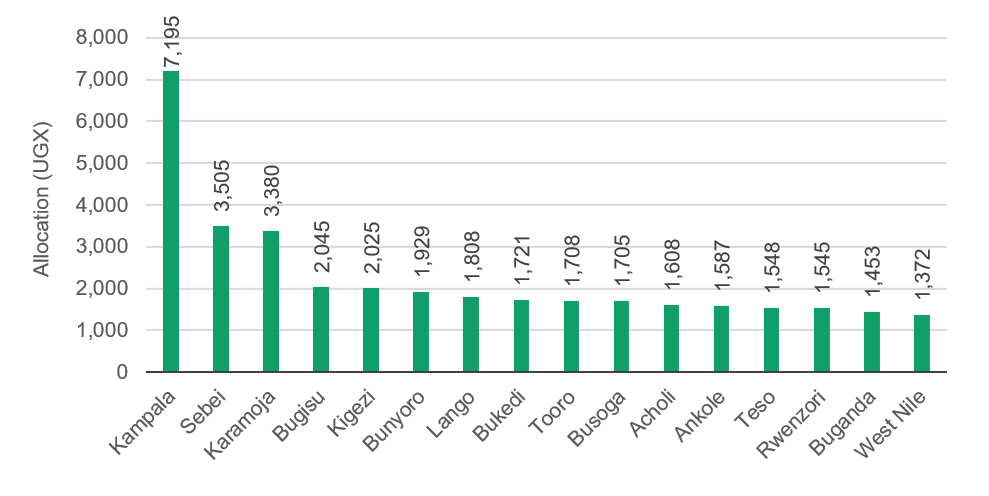
Figure 8: Low per capita WASH sector funding allocation for FY2017/18 (UGX)
Source: Development Initiatives based on data from the government of Uganda. [66]
While Uganda’s increasing urbanisation is attracting a growing number of people to urban areas, the majority of Ugandans still live outside major cities and towns. However, the government continues to focus its investments and resource allocations in the WASH sector towards urban areas (Figure 9). The continuation of this trend and the inequitable distribution of public resources in other sectors during the Covid-19 pandemic is likely to disproportionately impact people living in poverty who are often left out in planning and allocation of resources and exposed to increased risk of infections.
Figure 9: Higher per capita government urban expenditure on water and sanitation, FY2015/16 to FY2017/18 (US$)
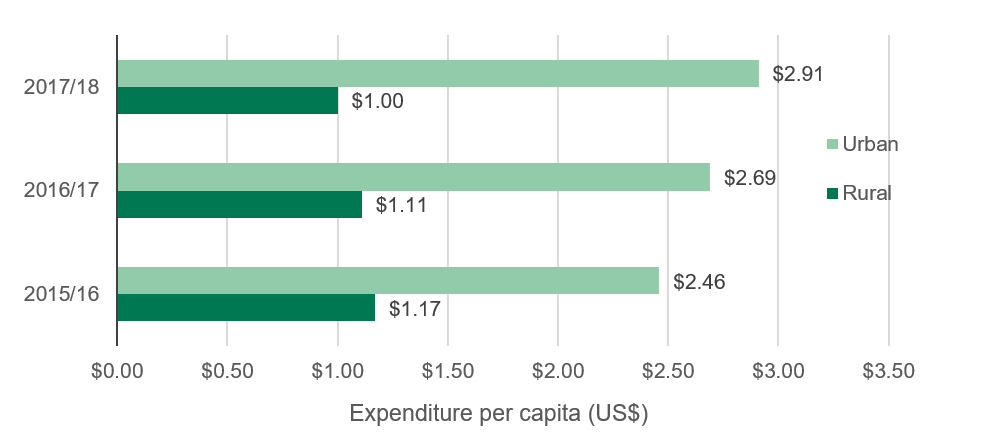
Figure 9: Higher per capita government urban expenditure on water and sanitation, FY2015/16 to FY2017/18 (US$)
Source: Development Initiatives based on data from UNICEF. [67]
Some of the recommended Covid-19 prevention strategies, such as regular handwashing with soap, require access to adequate supply of clean water. While Uganda’s current rural safe water coverage stands at 72%, not all water sources are functional. Approximately 16% of these water sources are rated as non-functional.
Impacts of the Covid-19 pandemic on the economy
Uganda’s growth forecast was revised down from a previous estimate of 6% to 3–4% from the second half of FY2019/20 [68] due to the impact of Covid-19. The service sector which accounts for over 50% of Uganda’s GDP [69] will be most affected, [70] as the lockdown and other Covid-19 response measures have halted key activities such as tourism and hotels which are Uganda’s top foreign exchange earners.
Likewise, Uganda’s economy is expected to feel the impact of the slowdown of the global economy, leading to weak demand for its export commodities. As such, the economy is projected to lose a significant share of its export earnings from agriculture, remittances from abroad, foreign direct investment (FDI) and the tourism sector. [71] By February 2020 Uganda’s exports had already declined by US$31 million (UGX 114.23 billion, converted on 7 August 2020) or 8% while imports declined by US$108 million (UGX 398 billion, converted on 7 August 2020) or 15% from February to March 2020. [72]
While a slump in imports has offered Uganda a chance to expedite its import substitution strategies under the ‘Buy Uganda Build Uganda’ framework, [73] experts warn that the economy could lose up to US$1.45 billion (UGX 5.34 trillion, converted on 7 August 2020) or an equivalent of 8% of its total export earnings because of the lockdown and global travel restrictions which affect the tourism sector. [74] The ministry of finance warns that damage to the economy could continue until the virus is contained at global level or restrictive response measures lifted locally. [75]
Uganda also exports labour to several Middle East countries. This adds to the number of Ugandan migrants in other countries who send remittances back to support their families in Uganda. At global level, the flow of remittances is predicted to decline by 20% in 2020 due to the economic crisis induced by Covid-19 pandemic. [76] This is attributed to the direct impact of response measures such as lockdowns, a fall in wages and a decrease in the employment of migrant workers who finance many poor and vulnerable households in low income countries.
“Remittances help families afford food, healthcare, and basic needs. As the World Bank Group implements fast, broad action to support countries, we are working to keep remittance channels open and safeguard the poorest communities’ access to these most basic needs.”
World Bank
Given the large share of the informal sector in Uganda’s GDP (50%) and employment (98% of the working age labour force), [77] Covid-19 response measures have negatively impacted on Uganda’s economy and affected people’s livelihoods. A total lockdown of the country has resulted in immediate job losses for many Ugandans employed mainly in the informal sector. All teachers in private schools, many boda-boda taxi riders, roadside food venders, petty traders and dealers in non-food items have lost their livelihoods. Those in the formal sector have also been affected. Many employers in the private sector have terminated staff contracts because they can no longer afford to pay their staff. [78] [79]
Major shortfalls in domestic revenue collection
Uganda’s revenue collection will also be affected by the pandemic. The Uganda Revenue Authority (URA) already registered a shortfall of UGX 858.1 billion in domestic revenue in the period from July to October 2019 and is expected to register further shortfalls as a result of the impact of Covid-19. The ministry of finance warns that revenue collection could register a further shortfall of UGX 82.4 billion shillings (US$21.5 million) in the last quarter of 2020 and another UGX 187.6 billion in the coming financial year, even if the virus is quickly contained. This means that shortfalls in revenue collection could significantly exceed projections if the spread of Covid-19 continues necessitating implementation of restrictive control measures.
Major shortfalls in revenue and tax collection could result from a prolonged freeze in economic activity, as many Uganda’s taxpayers will not be able to work or pay taxes under an extended lockdown or restrictive response measures. International Monetary Fund (IMF) growth projections reveal that Uganda could experience between US$0.86 billion (UGX 1,368.8 trillion, converted on 7 August 2020) and US$1.77 billion (UGX 6.522 trillion, converted on 7 August 2020) shortfall in projected revenue for 2021 (Figure 10).
Figure 10: Uganda’s revenue projection scenarios for 2019–2021
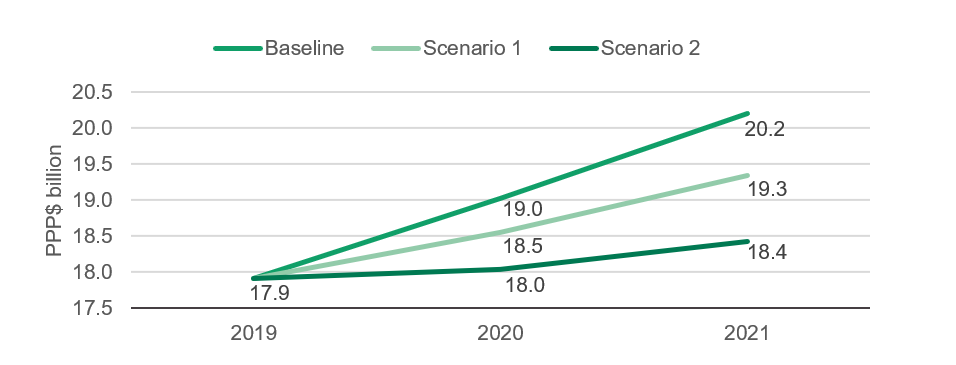
Figure 10: Uganda’s revenue projection scenarios for 2019–2021
Source: Development Initiatives based on data from IMF growth projections translated into revenue projections. [80]
Note: Purchasing power parity (PPP) prices are the rate at which a country's currency would have to be converted into that of another country to buy the same amount of goods and services in each country. PPPs are constructed by comparing the cost of a common basket of goods in different countries.
Increasing public debt
With anticipated major shortfalls in revenue collection, the government has already resorted to borrowing to cover its fiscal deficit for both FY2019/20 and FY2020/21. A total of UGX 4,321 billion has so far been borrowed including US$492 million or UGX 1,868 billion from the IMF [81] and Euro600 or UGX 2,454 billion from the EU. [82] If unabated, this will contribute to further increase the total public debt which has increased from 22.4% in 2010 to a projected 41% of GDP by the end of FY2019/20 (Figure 11). In FY2019/20, total public debt grew from UGX 46.36 trillion in first quarter to UGX 48.91 trillion at the end of the second quarter. [83] This trend is a major challenge for a country whose debt servicing commitments have steadily increased as rising external public loan financing continues to attract high commitment fees.
The additional pressure of Covid-19 on the budget of sectors like health, security and ICT has increased Uganda’s budget deficit for FY2019/20, forcing the government to borrow another US$100 million [86] (UGX 368 billion, converted on 7 August 2020) in addition to the US$661 million (UGX 2.44 trillion, converted on 7 August 2020) that was required to meet the 2019/20 budget deficit. [87]
Increased domestic and external borrowing is likely to plunge the country into more debt distress, compromise debt sustainability in the medium to long term and drain the resources that would have been allocated to finance basic service delivery and development to benefit people living in poverty. Uganda spends a significant chunk of its budget in debt servicing with 9% and 2.7% of the FY2020/21 budget allocated to interest payments and external debt repayments respectively. Another 16.5% of the budget is allocated to domestic refinancing. This will disproportionately affect people living in poverty, as the government’s policy on debt payments lowers investments in sectors that directly benefit people living in poverty, like water, sanitation and hygiene (WASH), health, and social protection. These are the sectors that most need increased financing in the face of the Covid-19 pandemic.
Increase in poverty and vulnerability
Uganda’s national poverty rate stands at 19.7%. This means there are 8 million Ugandans living under the national poverty line. [88] While this is a significant decline from the 31.1% level in 2006, [89] it is estimated that one in five Ugandans still lives in extreme poverty and more than a third live on less than US$1.90 (UGX 7,000, converted on 7 August 2020) a day. [90] Some estimates for the potential impact of the Covid-19 pandemic on poverty incidence places Uganda among the top ten contributors to additional global poverty as a result of unemployment and labour income shocks associated with Covid-19 response measures, such as lockdowns. [91]
Over 13.67 million or 98% of Uganda’s total working age population are engaged in the informal sector. [92] Commonly, business operations in the informal sector are neither registered nor protected by the state, have no registered interests or assets, and are vulnerable and excluded from governments impact mitigation programmes for businesses, as well as social safety nets and protection accorded by formal labour contracts. [93]
The lockdown and other Covid-19 related restrictions have affected the operation of informal businesses and SMEs that continue to pay rent for premises without operations. Some continue to pay wages to employees that are not working, servicing loans that are not being put into productive use, while the few that are operating are buying input at higher than normal prices. With close to 50% of Ugandan businesses not surviving past their third birthday under normal circumstances, [94] it is likely that investments, jobs and livelihoods will be lost because of the Covid-19 pandemic.
While people living in poverty in urban areas are at greatest risk of suffering immediate loss of income due to lockdown measures, people living in rural areas are also at risk of falling back into poverty due to heavy dependence on subsistence rain-fed agriculture for their livelihoods. [95] The vulnerability of people living in poverty is worsened by extreme weather events, such as drought and floods, as well as infestations and health risks including illness, disability and epidemics. [96] [97]
The Covid-19 pandemic is therefore likely to compromise Uganda’s achievement in poverty reduction which has been attributed to the favourable food prices and weather that boosted the income of agricultural households in recent years. The impacts of Covid-19 at a global level is likely to effect commodity prices as demand falls. This will have a direct impact on the livelihoods of many vulnerable households and push many people that had previously got out of poverty back below the poverty line.
The short-term response measures, like food distribution targeting only the urban poor vulnerable households during lockdown, have had little impact in reducing the effects of Covid-19 on those living in poverty in Uganda. This also applies to ill-targeted economic stimulus that are benefit workers in the formal sector rather than those in the informal sector.
Increasing food insecurity for urban poor households
Most households in Uganda were considered as largely food secure in the period prior to Covid-19. However, the imposition of the nationwide lockdown and other restrictions in response to the pandemic has disrupted food supply chains and impacted income earning opportunities for most people. People living in poverty in urban areas, who largely rely on casual jobs in the informal sector, have been disproportionately affected due to reduced access to income and high dependence on market purchases. [98] Food security experts warn that while urban areas are likely to transition to a normal food security situation as the first harvest from July lowers food prices, the poorest households in urban areas are likely to face increased food insecurity through much of the remaining months of the year. [99]
At macro level, agriculture remains the mainstay of Uganda’s economy, supporting the livelihoods of over 70% of the population, most of whom rely solely on subsistence agriculture for their livelihood. [100] Uganda’s informal sector, which contributes over 50% of GDP, is also closely linked with the agricultural sector. [101] It’s therefore likely that the negative impacts of the Covid-19 pandemic on agriculture will have a knock-on effect on other sectors, including industries that rely on inputs from the agricultural sector, thus reducing productivity and economic growth.
In addition to Covid-19, Uganda is also facing a locust invasion affecting crop production in parts of the northern and eastern regions. Added to this, the impact of flooding and landslides that have occurred across the country as a result in high levels of rain could have a significant negative impact on Uganda’s food security situation. So far, over 100,000 people are reported to have been displaced and many people have died due to the floods in western, central and northern Uganda that have also destroyed infrastructure and food crops. [102]
Alongside the Covid-19 pandemic, these natural disasters have affected the harvest and caused increased food insecurity in the worst-hit areas. The poorest and most vulnerable communities, including persons with disability, women and child-headed households, are likely to suffer the most.
Conclusions
With just four Covid-19 related death reported so far, relatively low numbers of confirmed cases and a high rate of recoveries, Uganda’s tightly-controlled response to the Covid-19 pandemic seems to have yielded more positive outcomes than its neighbours.
However, the severe lockdown and response measures that have succeeded in containing the outbreak have also caused significant damage to the economy.
A likely increase in poverty as the economy slows down: The economy is projected to have slowed down by nearly half for FY2019/20, with further uncertainties for FY2020/21. This increases the likelihood of a rise in poverty during and after the Covid19 pandemic. Many people face a reduction in their income due to job and livelihood losses, reduced flow of remittances, loss of market and demand for domestic products.
Growing expenditures not linked to Covid-19: While government expenditures for FY2020/21 have grown, much of this increase does not seem to be driven by the anticipated cost of responding to the impact of Covid-19. The structure of the current budget remains largely similar to the previous financial year. The key drivers of the budget increase are the increased allocations to security, interest payments and education which are also among the usual top 4 financed sectors of the economy.
Shortfall in revenue collection as the pandemic continues to impact negatively on the economy: While total revenue is expected to grow, Uganda’s revenue collection will be affected by the pandemic. Major shortfalls have already been registered in FY2019/20. There are also projections for declines in FY2020/21 targets. These projections are based on a situation where the virus is quickly contained, but these shortfalls could significantly exceed projections if the current restrictive control measures continue.
Rising public debt as government resorts to borrowing to cover revenue shortfalls: Major shortfalls revenue collection pushed the government into high levels of borrowing to cover its fiscal deficit for both FY2019/20 and FY2020/21. If this continues, it will contribute to a further increase in total public debt, which has grown from 22.4% in 2010 to a projected 41% of GDP in by the end of FY2019/20. This is a major challenge as Uganda’s debt servicing commitments have steadily increased as rising external public loan financing continues to attract high commitment fees. Increasing debt implies that more money will be allocated to interest payment, which could have been aligned to operation and maintenance activities or development spending. Secondly, increased borrowing from domestic source crowds out investment in the private sector and that affects employment and output. Government should focus on fiscal prudence by ensuring efficient use of available resources and increasing resource mobilisation by widening the tax base.
Formal sector and urban bias of Covid-19 relief points to poor targeting of response: Over 8 million Ugandans (19.7%) live below the national poverty line. However, the government’s Covid-19 relief programmes, like food and other relief aid, have been directed primarily at 1.5 million people living in urban areas, like Kampala and Wakiso, rather than those in other parts of the country. Similarly, the government’s response measures are focused on the formal sector, meaning that they will not reach people living in poverty and most vulnerable citizens. These people tend to work in the informal sector, and are unable to access government measures like loans and tax benefits. This is likely to cause further inequality between rural and urban populations, and exacerbate poverty and vulnerability among the excluded.
Disruption of service delivery in health and other sectors: Due to Covid-19, Ugandans living in poverty who rely on the free healthcare programme have experienced a reduced access to primary healthcare. As a result, Uganda has registered an increase in number of preventable deaths during childbirth and in other health emergencies, and an increased occurrence of deaths due to preventable disease like malaria.
Poor service delivery outcomes in health sector: While there is not clear link between expenditure allocations, actual spending and social outcomes in health, there is evidence of sustained underfunding in all of the sectors that would benefit people living in poverty. This has been the direct cause of some of the challenges the sectors faced prior to the Covid-19 pandemic. However, these challenges are now amplified under competing demands and shifting priorities in the face of the pandemic, especially in the health sector.
The structure of the FY2020/21 national budget is similar to that of the previous years: This suggests that the impact of the Covid-19 pandemic has not been reflected in the planning and allocation of resources for FY2019/20. This is likely to result in financing gaps and requests for supplementary funding, as happened in the previous financial year.
Recommendations
This paper therefore provides the following recommendations:
- Urban and formal sector learning measures need to be applied in a way that is clear and inclusive with a short-, medium- and long-term plan for mitigation, recovery and resilience building. This is the only way to ensure that the damaging impacts of the severe lockdown and other Covid-19 response measures on the economy, people’s livelihoods and welfare are properly documented and addressed equitably.
- A clear government response strategy is needed, to ensure adequate attention and protection for the poorest and most vulnerable sections of the population. This will protect against the negative impact of the pandemic on the health and livelihoods of the most vulnerable.
- The FY2020/21 funding allocation to pro-poor sectors, such as health and social protection, needs to be revised to reflect sector needs and accommodate additional constraints imposed by Covid-19. This will enable the government to, for example, fast-track the expansion of its social protection programmes and serve as a more direct, sustainable and inclusive mechanism for protecting people living in poverty.
- The drawbacks of the restrictive Covid-19 response measures should be documented across sectors and used as lessons for designing responses in future crises. This will prevent inadvertent loss of many lives from existing and manageable conditions due to poor responses to crises in future.
- The government needs to pay close attention its rising fiscal deficit and the increase in public debt towards unsustainable levels. The increase in loans to deal with the implications of the Covid-19 pandemic should be checked. This calls for clear mechanisms for good public debt management as well as the efficient use of available resources to avoid slipping deeper into debt stress.
Abbreviations and acronyms
| FY | Financial year |
| ICT | Information and communication technology |
| ICU | Intensive care unit |
| IMF | International Monetary Fund |
| NITAU | National Information Technology Authority Uganda |
| SME | Small and medium enterprises |
| UGX | Uganda shillings |
| WASH | Water, sanitation and hygiene |
Downloads
Notes
-
1
This number includes both Ugandans and non-Ugandans.Return to source text
-
2
The Government of Uganda. Covid-19 response information hub. https://covid19.gou.go.ug/statistics.html (accessed 7 August 2020)Return to source text
-
3
The Independent, 2020. Fear of another lockdown. Available at: https://www.independent.co.ug/fear-of-another-lockdown/ (accessed 8 July 2020)Return to source text
-
4
The Independent, 2020. Unpacking Uganda’s Informal Sector. Available at: https://www.independent.co.ug/unpacking-ugandas-informal-sector/ (accessed 3 July 2020)Return to source text
-
5
Pozhidaev. D, 2020. Impact of COVID-19 on Ugandan MSMEs Informal sector. Available at: https://www.academia.edu/43362544/Impact_of_COVID-19_on_Ugandan_MSMEs_Informal_sector (accessed 3 August 2020)Return to source text
Related content
National factors helping aid-funded programmes deliver: Kenya, Uganda, Ethiopia
Results from case studies on social protection, agriculture and health, programmes receiving ODA in Kenya, Uganda and Ethiopia
ODA financing the climate–gender–disability interface: Key facts
Donors and African domestic budget allocators must consider the impact of climate change on women and girls with disabilities when making financing decisions
Vulnerability and resilience: How does Uganda’s data ecosystem inform social protection systems?
This report assesses Uganda's vulnerability and resilience data landscape. It evaluates the data ecosystem that informs social protection systems and makes recommendations to leave no one behind.
